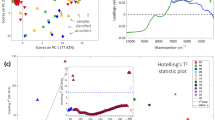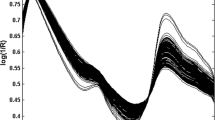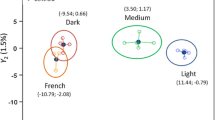Abstract
Online monitoring of coffee roasting in an industrial plant is becoming an important issue as the experience of the roast master still plays an important role. Despite several approaches have been tested, some limitations were not surmountable as difficulties in scalability from bench scale to industrial roaster, the use of expensive analytical instrumentation, and the need to handle a large dataset of variables. In this paper, response of an electronic nose sampling, the headspace of roasted beans, was correlated with brightness and mean density, using the generalized least square regression in combination with a stepwise backward selection of predictors. To avoid scalability issues, roasting took place in an industrial plant using two Arabica (Brazil and Costa Rica) and two Robusta (Vietnam and India) origins. Regression showed R 2 ranging in the interval 0.994–0.999, with statistical significance p < 0.0001. The present approach has the potential to be used effectively instead of roast master, in the online monitoring of coffee roasting in industrial plants.


Similar content being viewed by others
References
Alessandrini L, Romani S, Pinnavaia G, Rosa MD (2008) Near infrared spectroscopy: an analytical tool to predict coffee roasting degree. Anal Chim Acta 625:95–102. doi:10.1016/j.aca.2008.07.013
Amemiya T (1985) Generalized least squares theory. Harvard University Press, Cambridge Massachusetts, Advanced Econometrics
Berna A (2010) Metal oxide sensors for electronic noses and their application to food analysis. Sensors 10:3882–3910. doi:10.3390/s100403882
Brattoli M, Cisternino E, Rosario Dambruoso P et al (2013) Gas chromatography analysis with olfactometric detection (GC-O) as a useful methodology for chemical characterization of odorous compounds. Sensors (Switzerland) 13:16759–16800. doi:10.3390/s131216759
Deshmukh S, Jana A, Bhattacharyya N et al (2014) Quantitative determination of pulp and paper industry emissions and associated odor intensity in methyl mercaptan equivalent using electronic nose. Atmos Environ 82:401–409. doi:10.1016/j.atmosenv.2013.10.041
Dutra ER, Oliveira LS, Franca AS et al (2001) Preliminary study on the feasibility of using the composition of coffee roasting exhaust gas for the determination of the degree of roast. J Food Eng 47:241–246. doi:10.1016/S0260-8774(00)00116-3
Engle RF (1984) Wald, likelihood ratio, and Lagrange multiplier tests in econometrics. Handb Econom 2:775–826
Falasconi M, Pardo M, Sberveglieri G et al (2005) The novel EOS835 electronic nose and data analysis for evaluating coffee ripening. Sensors Actuators B Chem 110:73–80. doi:10.1016/j.snb.2005.01.019
Forina M, Lanteri S, Casale M, Cerrato Oliveros MC (2007) Stepwise orthogonalization of predictors in classification and regression techniques: an “old” technique revisited. Chemom Intell Lab Syst 87:252–261. doi:10.1016/j.chemolab.2007.03.003
Franca AS, Oliveira LS, Mendonça JCF, Silva XA (2005) Physical and chemical attributes of defective crude and roasted coffee beans. Food Chem 90:89–94. doi:10.1016/j.foodchem.2004.03.028
Gardner JW, Shurmer HV, Tan TT (1992) Application of an electronic nose to the discrimination of coffees. Sensors Actuators B Chem 6:71–75. doi:10.1016/0925-4005(92)80033-T
Giungato P, de Gennaro G, Barbieri P et al (2016) Improving recognition of odors in a waste management plant by using electronic noses with different technologies, gas chromatography-mass spectrometry/olfactometry and dynamic olfactometry. J Clean Prod 133:1395–1402. doi:10.1016/j.jclepro.2016.05.148
Giungato P, Elisabetta L, Cervone F (2010) Modificazioni indotte dai processi di tostatura industriale neichicchidicaffè indaginicolorimetriche. Ind Aliment 49:25–33
Gloess AN, Vietri A, Wieland F et al (2014) Evidence of different flavour formation dynamics by roasting coffee from different origins: on-line analysis with PTR-ToF-MS. Int J Mass Spectrom 365–366:324–337. doi:10.1016/j.ijms.2014.02.010
Gökmen V, Şenyuva HZ (2006) Study of colour and acrylamide formation in coffee, wheat flour and potato chips during heating. Food Chem 99:238–243. doi:10.1016/j.foodchem.2005.06.054
Granato D, de Araújo Calado VM, Jarvis B (2014) Observations on the use of statistical methods in food science and technology. Food Res Int 55:137–149. doi:10.1016/j.foodres.2013.10.024
Greene WH (2003) Econometric analysis, 5th edn. Prentice Hall, Upper Saddle River, New Jersey
Grosch W (1993) Detection of potent odorants in foods by aroma extract dilution analysis. Trends Food Sci Technol 4:68–73. doi:10.1016/0924-2244(93)90187-F
Harrell FE (2001) Regression modeling strategies: with applications to linear models, logistic regression, and survival analysis. Springer Verlag, New York
Hernández JA, Heyd B, Trystram G (2008) Prediction of brightness and surface area kinetics during coffee roasting. J Food Eng 89:156–163. doi:10.1016/j.jfoodeng.2008.04.026
Hertz-Schünemann R, Dorfner R, Yeretzian C et al (2013a) On-line process monitoring of coffee roasting by resonant laser ionisation time-of-flight mass spectrometry: bridging the gap from industrial batch roasting to flavour formation inside an individual coffee bean. J Mass Spectrom 48:1253–1265. doi:10.1002/jms.3299
Hertz-Schünemann R, Streibel T, Ehlert S, Zimmermann R (2013b) Looking into individual coffee beans during the roasting process: direct micro-probe sampling on-line photo-ionisation mass spectrometric analysis of coffee roasting gases. Anal Bioanal Chem 405:7083–7096. doi:10.1007/s00216-013-7006-y
Houwelingen HC Van, Sauerbrei W (2013) Cross-validation, shrinkage and variable selection in linear regression revisited. Open J Stat 3:79–102. doi: 10.4236/ojs.2013.32011
Mendes LC, De Menezes HC, Aparecida M, Da Silva AP (2001) Optimization of the roasting of robusta coffee (C. canephora conillon) using acceptability tests and RSM. Food Qual Prefer 12:153–162. doi:10.1016/S0950-3293(00)00042-2
Mendonca JCF, Franca AS, Oliveira LS (2009) Physical characterization of non-defective and defective Arabica and Robusta coffees before and after roasting. J Food Eng 92:474–479. doi:10.1016/j.jfoodeng.2008.12.023
Pardo M, Niederjaufner G, Benussi G et al (2000) Data preprocessing enhances the classification of different brands of espresso coffee with an electronic nose. Sensors Actuators B Chem 69:397–403. doi:10.1016/S0925-4005(00)00499-8
Pathare PB, Opara UL, Al-Said FAJ (2013) Colour measurement and analysis in fresh and processed foods: a review. Food Bioprocess Technol 6:36–60. doi:10.1007/s11947-012-0867-9
Pittia P, Dalla Rosa M, Lerici C (2001) Textural changes of coffee beans as affected by roasting conditions. Leb u-Technol 175:168–175. doi:10.1006/fstl.2000.0749
Pizarro C, Esteban-Díez I, González-Sáiz J-M, Forina M (2007) Use of near-infrared spectroscopy and feature selection techniques for predicting the caffeine content and roasting color in roasted coffees. J Agric Food Chem 55:7477–7488. doi:10.1021/jf071139x
Roberts JJ, Cozzolino D (2016) An overview on the application of chemometrics in food science and technology—an approach to quantitative data analysis. Food Anal Methods 9:3258–3267. doi:10.1007/s12161-016-0574-7
Rodriguez J, Duran C, Reyes A (2010) Electronic nose for quality control of Colombian coffee through the detection of defects in “Cup Tests.” Sensors 10:36–46. doi: 10.3390/s100100036
Romani S, Cevoli C, Fabbri A et al (2012) Evaluation of coffee roasting degree by using electronic nose and artificial neural network for off-line quality control. J Food Sci 77:960–965. doi:10.1111/j.1750-3841.2012.02851.x
Santos JR, Lopo M, Rangel AOSS, Lopes JA (2016a) Exploiting near infrared spectroscopy as an analytical tool for on-line monitoring of acidity during coffee roasting. Food Control 60:408–415. doi:10.1016/j.foodcont.2015.08.007
Santos JR, Viegas O, Páscoa RNMJ et al (2016b) In-line monitoring of the coffee roasting process with near infrared spectroscopy: measurement of sucrose and colour. Food Chem 208:103–110. doi:10.1016/j.foodchem.2016.03.114
Sapra S (2005) A regression error specification test (RESET) for generalized linear models.
Senyuva HZ, Gökmen V (2005) Study of acrylamide in coffee using an improved liquid chromatography mass spectrometry method: investigation of colour changes and acrylamide formation in coffee during roasting. Food Addit Contam 22:214–220. doi:10.1080/02652030500109834
Wieland F, Gloess AN, Keller M et al (2012) Online monitoring of coffee roasting by proton transfer reaction time-of-flight mass spectrometry (PTR-ToF-MS): towards a real-time process control for a consistent roast profile. Anal Bioanal Chem 402:2531–2543. doi:10.1007/s00216-011-5401-9
Acknowledgments
The authors acknowledge the University of Bari “Aldo Moro” for financial support from the Athenaeum funds year 2012 and SAICAF SpA, Bari, Italy, for providing the coffee samples and roasting. The authors would like to thank Prof. E. Quaranta and A. Tursi for permissions to use spectrophotometers of the Scientific and Technological Pole “Magna Grecia” in Taranto, Prof. G. de Gennaro for the electronic nose usage, and Prof. M. Forina for having furnished us the software PARVUS. This work is the result of the authors’ commitment, starting from the idea and ending with its accomplishment. Particularly, each author contributed as follows: Giungato P. for the study conception, electronic nose and color measurements, statistics, discussion of results, and drafting of manuscript; Nicolardi V. for statistics, discussion of results, and drafting of manuscript; and Laiola E. for sampling, density measurements, and discussion of results.
Author information
Authors and Affiliations
Corresponding author
Ethics declarations
Funding
This study was funded by the Athenaeum funds of the University of Bari Aldo Moro (grant number 2012).
Ethical Approval
This article does not contain any studies with human participants or animals performed by any of the authors.
Informed Consent
Not applicable.
Conflict of Interest
Giungato Pasquale declares that he has no conflict of interest. Nicolardi Vittorio declares that he has no conflict of interest. Laiola Elisabetta declares that she has no conflict of interest.
Rights and permissions
About this article
Cite this article
Giungato, P., Laiola, E. & Nicolardi, V. Evaluation of Industrial Roasting Degree of Coffee Beans by Using an Electronic Nose and a Stepwise Backward Selection of Predictors. Food Anal. Methods 10, 3424–3433 (2017). https://doi.org/10.1007/s12161-017-0909-z
Received:
Accepted:
Published:
Issue Date:
DOI: https://doi.org/10.1007/s12161-017-0909-z




